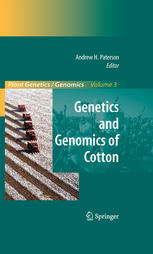

Most ebook files are in PDF format, so you can easily read them using various software such as Foxit Reader or directly on the Google Chrome browser.
Some ebook files are released by publishers in other formats such as .awz, .mobi, .epub, .fb2, etc. You may need to install specific software to read these formats on mobile/PC, such as Calibre.
Please read the tutorial at this link: https://ebookbell.com/faq
We offer FREE conversion to the popular formats you request; however, this may take some time. Therefore, right after payment, please email us, and we will try to provide the service as quickly as possible.
For some exceptional file formats or broken links (if any), please refrain from opening any disputes. Instead, email us first, and we will try to assist within a maximum of 6 hours.
EbookBell Team

0.0
0 reviewsGenetics and Genomics of Cotton
Edited by Andrew H. Paterson
The Gossypium (cotton) genus presents unique opportunities to advance our understanding of the natural world. In particular, the evolution of cultivated cottons from their wild ancestors has involved a fascinating series of events that offer scientists the opportunity to dissect the evolution of a novel organ, the ‘lint fiber’, and also to better understand the roles of polyploidy in generation of biodiversity and in crop productivity and quality. Current and future cotton genomics studies are guided by a long history of classical genetics research, as well as nearly two decades of molecular genetics.
In this book, advances of the past decade will be summarized and synthesized to elucidate the current state of knowledge of the structure, function, and evolution of the Gossypium genome, and progress in the application of this knowledge to cotton improvement. As a backdrop, it is important to understand the naturally-occurring diversity in the genus, its organization and distribution, and its evolutionary history. Of special importance is the formation of a single polyploid from two (among 8) diploid genome types, the radiation of this polyploid, and the independent domestication and improvement of two (among nearly 50) diploid and two (among 5) polyploid species. Genomic tools for cotton biology and improvement have expanded dramatically in the past 5 years – a detailed summary of these tools and their early applications is central to this book. Application of genomic tools to priorities in cotton improvement, including the genetic control of variation in cotton fiber yield and quality components, disease and pest responses, and abiotic stress responses, are addressed. The anticipated sequencing of the genomes of several members of the genus and the new opportunities that this will create, are also addressed.
Andrew H. Paterson, Ph.D. is a Distinguished Research Professor at the University of Georgia, jointly appointed in three Departments (Crop and Soil Science, Plant Biology, and Genetics) and the director of the Plant Genome Mapping Laboratory (www.plantgenome.uga.edu). He has authored or co-authored 204 refereed publications, 53 book chapters, 6 patent applications, edited 2 previous books, and given 150 invited presentations. He is a member of the AAAS, GSA, CSSA, and several other professional organizations. Professor Paterson has been the recipient of the Crop Science Society of America "Young Crop Scientist of the Year" award (1996), the inaugural Cotton, Inc. Cotton Biotechnology award (2002), D. W. Brooks Award for Excellence in Research (2005), National Cotton Council Cotton Genetics Research Award (2008), and a Guggenheim Foundation Fellowship in Plant Sciences (2007-8). In addition, he has served on eight editorial boards, currently being an associate editor of Genetics, Theoretical and Applied Genetics, and Tropical Plant Biology, and is frequently an ad hoc reviewer and/or panelist for additional journals and granting agencies. He serves in several national and international research initiatives, including the steering committee of the International Cotton Genome Initiative.